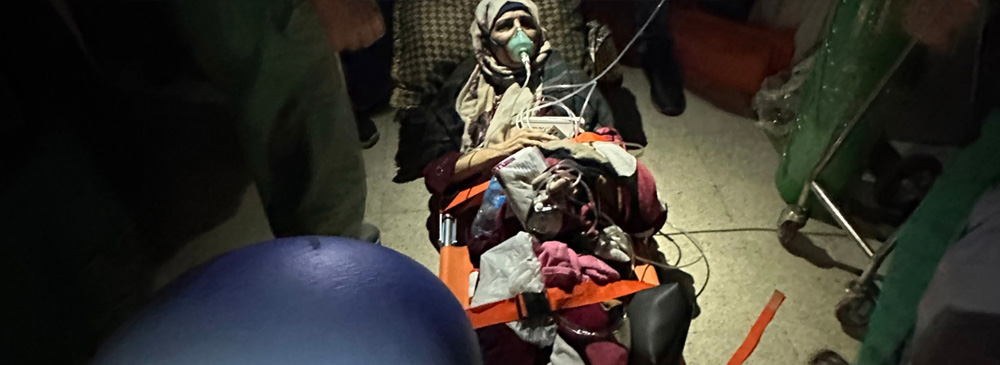
20 February 2024 – WHO led two life-saving missions to transfer 32 critical patients, including two children, from Nasser Medical Complex in southern Gaza on 18 and 19 February, amid ongoing hostilities and access restrictions. The high-risk missions were conducted in close partnership with the Palestine Red Crescent Society (PRCS) and the United Nations Office for the Coordination of Humanitarian Affairs (OCHA). The team also provided limited supplies of essential medicines and food for the remaining patients and staff who are otherwise cut off from aid.
Four PRCS ambulances ensured the safe transportation of the patients, who underwent medical assessment and triage under the coordination of the hospital director. Patients were moved to the European Gaza Hospital in Khan Younis, Al-Aqsa hospital in Gaza’s middle area, and the International Medical Corps, UAE and Indonesia field hospitals in Rafah.
The transfer of patients was requested by the hospital staff after the facility became non-functional following a military raid on 14 February, after a week-long siege. Weak and frail patients were transferred amidst active conflict near the aid convoy. Road conditions hindered the swift movement of ambulances, placing the health of patients at further risk. Patients transferred during the missions included three suffering from paralysis - two of them with tracheostomy - and several others with external fixators for severe orthopedic injuries. Two of the paralyzed patients required continuous manual ventilation throughout the journey, due to the lack of portable ventilators. A patient with a spinal fracture, previously referred to Nasser by WHO during a mission to Al-Ahli Hospital in northern Gaza, had to be transferred again despite his condition.
Nasser Hospital has no electricity or running water, and medical waste and garbage are creating a breeding ground for disease. WHO staff said the destruction around the hospital was ‘indescribable.’ The area was surrounded by burnt and destroyed buildings, heavy layers of debris, with no stretch of intact road.
An estimated 130 sick and injured patients and at least 15 doctors and nurses remain inside the hospital. As the ICU was no longer functioning, WHO staff transferred the only remaining ICU patient to a different part of the complex where other patients are receiving basic care.
WHO fears for the safety and well-being of the patients and health workers remaining in the hospital and warns that further disruption to lifesaving care for the sick and injured would lead to more deaths. Efforts to facilitate further patient referrals amidst the ongoing hostilities are in process.
Prior to the missions, WHO received two consecutive denials to access the hospital for medical assessment, causing delays in urgently needed patient referral. Reportedly, at least five patients died in the Intensive Care Unit before any missions or transfers were possible.
On 17 February, an UNRWA-led mission, which included WHO staff, delivered 24,000 liters of fuel and limited food and water supplies to the hospital, after not being able to reach it on 16 February due to unforgiving road conditions, including a deep, muddy, impassable ditch 50 meters from the hospital. That day, despite the risks, WHO staff, accompanied by an engineer, managed to reach Nasser Medical Complex on foot. However, they were only permitted to examine the generator, which had ceased functioning after running out of fuel. During both missions, senior WHO staff clearly identified themselves upon entering the hospital compound and requested approval to assess patients and evaluate hospital functionality. These requests were denied.
As the raid continues, any further damage to Nasser Medical Complex will mean even more delays in restoring functionality. The hospital’s large medical warehouse, along with supplies provided by WHO and partners, has burnt down, and the warehouse for day-to-day medical supplies is partly damaged. The WHO-supported limb reconstruction center, housed within the hospital, is no longer operational. These are tragic developments that will further limit access to health care in a context where needs continue to soar.
The dismantling and degradation of the Nasser Medical Complex is a massive blow to Gaza’s health system. Facilities in the south are already operating well beyond maximum capacity and are barely able to receive more patients.
WHO repeats its calls for the protection of patients, health workers, health infrastructure, and civilians. Hospitals must not be militarized, misused, or attacked.
WHO reiterates its calls for all parties to uphold international humanitarian law and the principles of precaution, distinction, and proportionality, and to ensure sustained access so hospitals can continue providing lifesaving care.
Photos: https://photos.emro.who.int/category/93/israelipalestinian-conflict-oct-2023-feb-2024?tab=categories
UNIFEED b-roll: https://www.unmultimedia.org/tv/unifeed/asset/3175/3175146/





